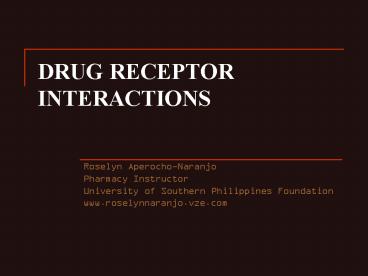DRUG RECEPTOR INTERACTIONS - PowerPoint PPT Presentation
1 / 15
Title:
DRUG RECEPTOR INTERACTIONS
Description:
DRUG RECEPTOR INTERACTIONS Roselyn Aperocho-Naranjo Pharmacy Instructor University of Southern Philippines Foundation www.roselynnaranjo.vze.com Definition of Terms ... – PowerPoint PPT presentation
Number of Views:107
Avg rating:3.0/5.0
Title: DRUG RECEPTOR INTERACTIONS
1
DRUG RECEPTOR INTERACTIONS
- Roselyn Aperocho-Naranjo
- Pharmacy Instructor
- University of Southern Philippines Foundation
- www.roselynnaranjo.vze.com
2
Definition of Terms
- Receptors are chemicals which binds to the drug
to exert a pharmacologic effect. - Formula
- D R D-R ------ Drug Response
- Note Binding of a drug to the receptor is
usually reversible - A Receptor is analogous to
- a switch in that it has two
- configurations ON and OFF
3
Definition of Terms
- Receptor
- Four Primary Receptor Families
- 1. Cell-membrane embedded
proteins - 2. Ligand-gated Ion Channel
- 3. G protein coupled Receptor
Systems - 4. Transcription Factors
4
Definition of Terms
- Agonist are molecules that activates receptors.
- - a drug that has both affinity
and high - intrinsic activity.
- Many drugs produce their effects
- by acting as an agonist.
- For example
- DOBUTAMINE - it mimics the action of
- norephenephrine at the receptors on
the heart. Thereby causing the heart to
contract and increase the heart beat.
5
Definition of Terms
- Affinity allows the agonist to bind to
receptors. - Intrinsic Activity allows the bound agonist to
-
activate or turn on its receptor -
function.
6
Definition of Terms
- Antagonist molecules that acts against and
blocks - drug action
Receptor
receiver
action
Agonist
Antagonist
against
7
Types of Antagonism
- Chemical Antagonism
- Interaction of drug (agonist) with another
chemical (antagonist) outside of receptor to form
an inactive complex. - Competitive Antagonism
- Drug (agonist) is displaced from drug-receptor
binding by another chemical (antagonist). - It is reversible and depends on actual drug and
antagonist concentration in the biophase. - Law of mass action
8
Types of Antagonism
- Partial Antagonism
- Antagonist has high affinity but low intrinsic
activity - Non-equilibrium Antagonism
- Antagonist forms irreversible receptor binding
- Noncompetitive Antagonism
- Agonist and antagonist bind to different
receptors and have opposite pharmacologic actions
9
Types of Pharmacologic Action of the Drugs
- Structural Non-specific Drugs
- - drugs which do not depend its pharmacologic
action to the chemical structure of the drug. - - only its structure affects its
physicochemical property. - - slight modification of its structure does not
produce a change in its pharmacologic action.
10
Types of Pharmacologic Action of the Drugs
- Structural Specific Drugs
- - drugs in which the pharmacologic action
directly depend on its chemical structure - - it attaches itself to a receptor in the
biophase - Three Prerequisites of the binding of
- drug to the receptor
- 1. chemical reactivity
- 2. presence of functional group
- 3. electronic distribution
- 4. mirror-like image of the receptor
11
Drug-Receptor Theories
- Hypothesis of Clark
- The Pharmacologic effect of the drug depends on
the percentage of the receptors occupied - If receptors are occupied, maximum effect is
obtained. - Chemical binding follow the Law of Mass Action.
12
Drug-Receptor Theories
- Hypothesis of Ariens and Stephenson
- Effectiveness of a drug lasts as long as the
receptor is occupied. Many substance possess
different effect , some have high affinity for
the receptor, some have low affinity and some are
not effective, and those ineffective substances
block or inhibit the receptor. - It is also called Occupation Theory.
13
Drug-Receptor Theories
- Hypothesis of Paton
- Effectiveness of a drug does not depend on
the actual occupation of the receptor but by
obtaining proper stimulus - This is also known as the Rate Theory.
14
Drug-Receptor Theories
- Lock and Key Hypothesis
- The drug molecule must fit into the receptor
like a key fits into the lock - Known as the Intrinsic Activity.
15
GOOD LUCKand Prepare ½ crosswise.

